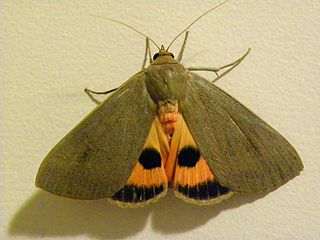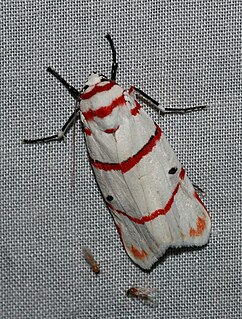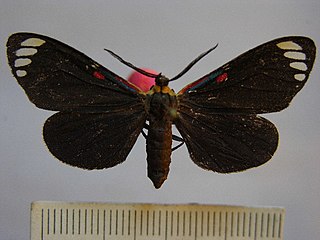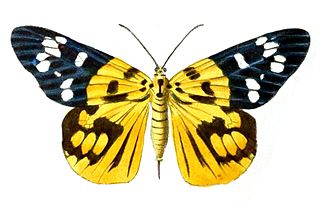
The geometer moths are moths belonging to the family Geometridae of the insect order Lepidoptera, the moths and butterflies. Their scientific name derives from the Ancient Greek geo γεω, and metron μέτρον "measure" in reference to the way their larvae, or inchworms, appear to measure the earth as they move along in a looping fashion. A very large family, it has around 23,000 species of moths described, and over 1400 species from six subfamilies indigenous to North America alone. A well-known member is the peppered moth, Biston betularia, which has been subject of numerous studies in population genetics. Several other geometer moths are notorious pests.

Gracillariidae is an important family of insects in the order Lepidoptera and the principal family of leaf miners that includes several economic, horticultural or recently invasive pest species such as the horse-chestnut leaf miner, Cameraria ohridella.

The Pyralini are a tribe of snout moths described by Pierre André Latreille in 1809. They belong to the subfamily Pyralinae, which contains the "typical" snout moths of the Old World and some other regions. The genus list presented here is provisional.

Geometrinae is the nominate subfamily of the geometer moth family (Geometridae). It is strongly split, containing a considerable number of tribes of which most are presently very small or monotypic. These small moths are often a light bluish green, leading to the common name of emerald moths, though a few species called thus are also found in the tribe Campaeini of the Ennominae. In 2018, a phylogeny and classification based on a molecular phylogenetic analysis was published in the Zoological Journal of the Linnean Society in which 13 tribes were accepted.

Hypena is a genus of moths in the family Erebidae. It was first described by Franz von Paula Schrank in 1802. These non-migratory moths overwinter as pupae and almost never estivate as adults.

Barsine is a genus of moths in the family Erebidae.

Ctenucha is a genus of moths in the family Erebidae.

Cyana is a genus of moths in the family Erebidae. Species are well distributed in Africa, Madagascar, China, India, Sri Lanka, Myanmar, Sumatra, Java and Borneo. The genus was erected by Francis Walker in 1854.

Lerina is a monotypic moth genus in the family Erebidae. Its only species, Lerina incarnata, the crimson-bodied lichen moth, is found in Mexico and southern Arizona. Both the genus and species were first described by Francis Walker in 1854.

Phaloesia is a monotypic of tiger moth genus in the family Erebidae. Its only species is Phaloesia saucia, the saucy beauty moth. The genus and species were first described by Francis Walker in 1854. It is found from the lower Rio Grande Valley of Texas in the United States to Venezuela.

Pseudosphex is a genus of tiger moths in the family Erebidae. The genus was erected by Jacob Hübner in 1818. These moths are mimics of a variety of Hymenoptera. The prefix pseudo means "false", and Sphex is a genus of wasps.

Zanclognatha is a genus of litter moths of the family Erebidae. The genus was erected by Julius Lederer in 1857.

Drymoea is a genus of moths in the family Geometridae erected by Francis Walker in 1854. This genus was originally proposed in the family Arctiidae, but was later transferred to the Geometridae. Some other genera were then included in this genus. The genus is confined to the Neotropical realm.

Dysphania is a genus of colourful moths in the family Geometridae and typical of the tribe Dysphaniini; they are sometimes called 'false tiger moths' and are found in northeast Australia, Melanesia, and south, east and southeast Asia.
Nelo is a genus of moths in the family Geometridae. Nelo discalis is the type species.

Dysphania is a plant genus in the family Amaranthaceae, distributed worldwide from the tropics and subtropics to warm-temperate regions.
Procotes is a monotypic moth genus in the Zygaenidae family described by Arthur Gardiner Butler in 1876. Its single species, Procotes diminuta, described by Francis Walker in 1854, is found in Sri Lanka.
Trypanophora trapobanes is a moth in the Zygaenidae family. It was described by Francis Walker in 1854 from Sri Lanka. Its larval host plants are in the genus Lagerstroemia.

Dysphania palmyra, the long blue tiger moth or blue day moth, is a moth of the family Geometridae. The species was first described by Caspar Stoll in 1790. It is found in India and Sri Lanka.

Psaphis is a genus of moths in the family Zygaenidae first described by Francis Walker in 1854. It is found in Southeast Asia and Australasia.

















